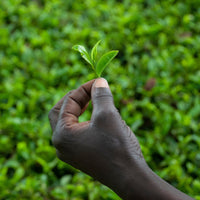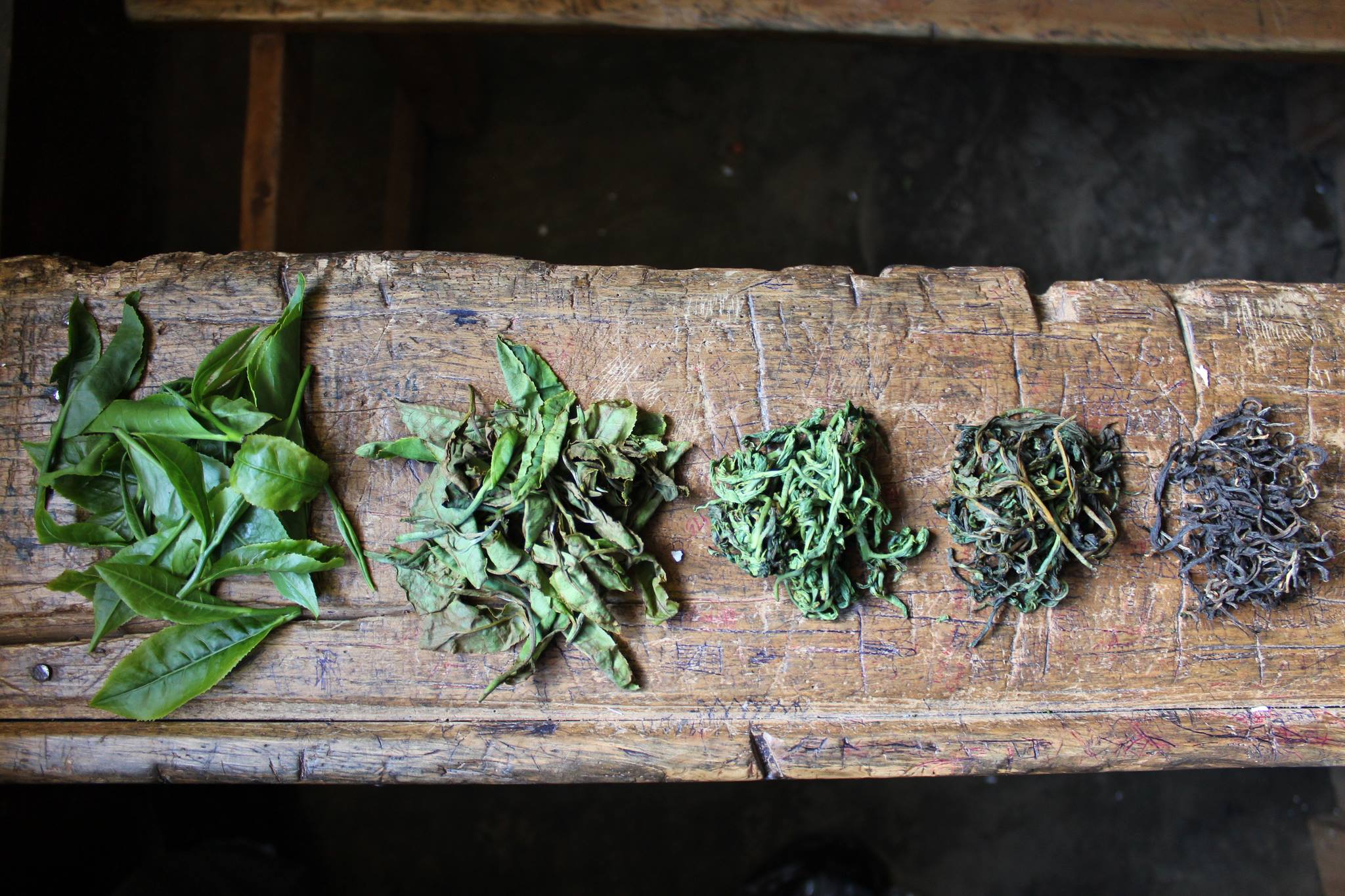
Hello!
JusTea offers the first and only farmer-direct tea from Kenya. If you like this blog post, check out the rest of our website.
Recent posts
-

-
 The History of TeaBy Paul BainJuly 29, 2022
The History of TeaBy Paul BainJuly 29, 2022

Explaining the Tea Making Process: How 7 Different Types of Tea are Made
By Paul Bain
Your tea-making process at home involves boiling water, reaching for your favourite tea leaves or tea bag, and grabbing a mug. But do you know how tea is processed during tea manufacturing? Find out how the process of green tea making differs from black tea processing and how exactly purple tea, oolong tea, yellow tea, pu erh, and white teas are made!
So, How is Tea Processed?
You might be surprised to know that all tea (we’re talking tea here, not the herbal stuff like rooibos, yerba mate, or any other tisanes) starts with the same leaves- those from the Camellia sinensis plant. It’s the processing of tea leaves that determines what type of tea it will become. If you’ve ever wondered, ‘how is tea processed?’, read on to find out how your favourite type of tea is created.
Here are the 7 Tea Making Process Steps

There are seven main tea making process steps, but the extent to which each one is used is different depending on the type of tea manufacturing.
1. Plucking the tea leaves
This is one step that every single type of tea must start with. After all, for tea manufacturing to happen, you need to remove the leaves from the plant first! Some teas require leaves to be plucked at a younger age, while others require a mature leaf. The most common pluck is 2 leaves and a bud, which is actually called the 'Pekoe' pluck (where the term Orange Pekoe came from!).

2. Letting the tea leaves wither
Like any other flower or plant, tea leaves will naturally begin to wither once they are plucked from the bush. The goal of this step is to let the moisture in the leaves evaporate. Depending on the type of tea, this is done by drying leaves under the sun or in a room with good ventilation. Withering also helps the leaves to soften so they won't break if you roll them.

3. Rolling, tossing, or crushing the tea leaves
Processing tea leaves requires breaking down some of the cell walls so that the air can react with them. This is done by shaking, tossing, crushing, and rolling the tea leaves to get them ready for oxidation.

4. Oxidizing the tea leaves
This is by far the most important part of the tea-making process. The level of oxidation is what determines what kind of tea is created. Once the cell walls of the leaves have been ruptured, they are left exposed to the air. The oxygen reacts with enzymes in the tea leaves and changes the chemical composition of the tea. The leaves gradually darken, just like any cut fruit does when left out (bite an apple and leave it on the counter, it will turn brown, oxidation!).
5. 'Fixing' the leaves by heating - locking in the flavour/health benefits
One key step in processing tea leaves is to heat them once the desired level of oxidation is achieved. Heating stops the enzymes in the tea leaves from any more oxidation. In other words, once the enzymes have done their job, heat is used to immobilize them. This step happens at various stages in the tea-making process depending on what type of tea you want to make (image of steamed green tea leaves below).
The tea leaf was 100% moisture when picked from the bush, during the above processing steps it slowly lost it's moisture content, and the goal of the drying stage is to bring that moisture all the way down to 3-7%. If the tea leaves are packed with too much moisture then they will get mouldy and expire faster (typically over 10%), and if they have too little moisture (less than 2%) the leaves will taste dry or burnt. Drying to the perfect moisture content means the tea will have a long shelf life and taste delicious!

7. Sorting the tea leaves
The final step in the tea factory process is sorting the tea leaves before they are packed. This involves the careful process of sifting through all the dried tea to remove any impurities, stems, or unrolled leaves.
Does Black Tea Processing Differ from Green Tea Processing and Other Teas?

You don’t have to be a tea connoisseur to know that there is an endless variety of flavours and colours when it comes to each type of tea. The strength, flavour, caffeine content, and colour of the tea all depends on the processing of the tea leaves.
How Processing Different Tea Leaves Gives Us a Wonderful Variety of Teas
Wondering how the tea making process steps above apply to create your preferred type of tea? Green tea processing is different from black tea processing, which is different from Oolong, White, Yellow, Pu Erh, or Purple tea processing! Here’s how the tea-making process differs for seven different types of tea:
Black tea processing differs from all other tea-making processes in that it has the longest oxidation step. Leaves are left to react with oxygen, so they become dark (hence the name black)
Green tea processing is pretty much the opposite of black tea processing when it comes to oxidation. To preserve the green colour of the fresh tea leaves and the lighter taste, green leaves are 'fixed' (heated by steaming or panning) early on during the process, usually right after plucking (often skipping the withering step). This allows green tea to keep its high level of antioxidants and why it’s famous for its Green Tea health benefits.
Oolong tea processing is the most complex because it involves repeating some steps of the tea making process several times to achieve the unique aroma and flavour. The rolling and oxidation steps are repeated over and over to get a tea that has characteristics roughly between a green tea and a black tea. It can either have light oxidation with similar colour to a Green Tea (10-30%), medium oxidation in between a green/black with camouflage coloured leaves (30-70%), or dark oxidation closer to a black tea but not fully oxidized like a black (70-90%).
White tea doesn’t involve much processing at all. The leaves are plucked and allowed to wither and air dry- or in some cases gently tumble dried when needed. These are not deliberately bruised to aid oxidation like the other teas. Many white teas focus on a very fine tea pluck from the bush, only the top bus (youngest tea shoot, unopened leaf) is selected for the tea (often called silver needles).
Yellow tea and Pu Erh tea are both types of fermented teas. Yellow tea leaves are fermented before being dried, which gives them a yellowish colour. Pu Erh teas undergo fermentation after the heating step of the tea-making process to produce an aged tea.
But wait... there is a new category of tea you haven't tried yet....
How Justea Makes Tea - Justly Made Tea

Now that you know all about the tea-making process, there’s a new, unique type of tea that you may want to try.... PURPLE TEA!

The Tea-Making Process for Purple Tea
Purple Tea is unique in that it only is made from Purple Tea leaves. All other teas are made from green tea leaves, but purple tea comes from a special Purple Tea cultivar (grown in Kenya). Purple Tea processing is most similar to an oolong or green tea. The leaves are picked and then withered like an oolong or black tea, but then after withering, they are 'fixed' like a green tea through steaming or panning. The withering step allows a deeper Purple Tea flavour to develop more, while the fixing stage (applying heat), locks in the Purple colour and health benefits!
JusTea’s tea-making process for our award-winning purple tea involves working with small-scale farmers in Kenya to produce handpicked organic, fair-trade purple tea. The purple tea leaves are not allowed to oxidize to ensure they remain packed with anthocyanins, antioxidants that offer incredible health benefits. Give purple tea a try today to experience these benefits and support our amazing Kenyan tea farmers at the same time!

